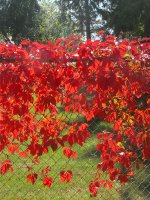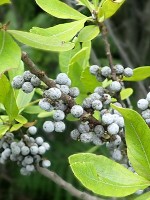Mon-Fri 9am - 5pm Mountain time
Virginia Creeper vs Northern Bayberry
Parthenocissus quinquefolia
Myrica pensylvanica
NOT AVAILABLE THIS SEASON - MIGHT RETURN
Virginia Creeper is a fast-growing, climbing vine. Its root-like tendrils attach themselves to any non-smooth surface, even brick, but will also grow as a ground cover.
Virginia Creeper makes a beautiful ornamental plant for your garden; its attractive foliage turns from green to deep red in the fall. Birds will love its red berries.
Northern Bayberry makes an excellent hedge or feature shrub. It will retain its leaves in warmer climates but drops them in colder areas. They produce blue-grey berries that have a wax coating on them that can be used to make candles or soaps.
In colder hardiness zones the leaves turn an attractive orange to red colour in the fall, making it a striking addition to your landscape.
Northern Bayberry is native to Nova Scotia and tolerates both drought and wet conditions. It is also a nitrogen fixer that tolerates poor soil conditions.
Virginia Creeper Quick Facts
Northern Bayberry Quick Facts
Toxicity: berries are toxic
Toxicity: Warning: The wax from bayberry fruit is considered toxic and may be carcinogenic.

